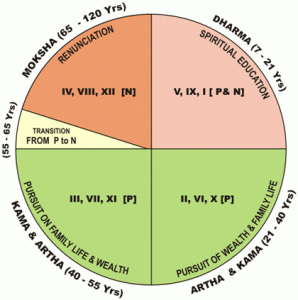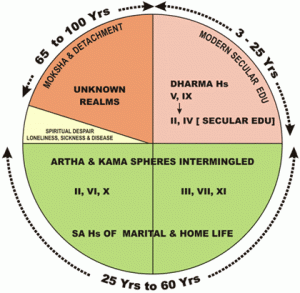Introduction
Dharma, Artha, Kama & Moksha
Goals Of Life In A Traditional Hindu Society

Meaning [above figure 1]: The goals of life or Purusharthas are shown. The transition from P [Pravritti or extroversion] to N [Nivritti or withdrawal] was possible in the first instance, only because Dharma was spiritual and influenced Artha & Kama as well. The stage of life marking the transition from P to N was called Vanaprastasrama. The word means withdrawal to a forest hermitage, far away from civilization. The Hs of VA for each goal are also shown. The Artha & Kama goals are always inseparably intertwined. II, VI, X are Artha Hs. III, VII, XI are Kama Hs. V, IX, I are Dharma Hs, while IV, VIII , XII are Moksha Hs.

Meaning [above figure 2]: How the classical goals or Purusharthas of a traditional Hindu Society have suffered a distortion in modern times is shown. ‘Moksha’ has lost its importance altogether & ‘Artha & Kama’ have become the most important goals. Dharma has become ‘secular & scientific’, losing its spiritual power entirely. The whole of life is only extroversion or Pravritti and the question of withdrawal from worldly life[Nivritti] does not exist.
For this reason, it is important to begin by taking a bird’s eye view of the Purusharthas, namely Dharma, Artha, Kama and Moksha which are the four goals and aspirations of human life in a traditional Vedic / Hindu society. Purusharthas would mean ‘the goals of man’. Purusha means the embodied spirit, i.e.; man and Artha would mean, that goal or life-purpose, at that particular stage in life.
(i). ‘Dharma’ in VA: In that traditional Hindu society, children and youth, between the ages of 7 & 21 yrs were given the opportunity for intensely pursuing the goal of Dharma or spiritual learning; which was usually at the feet of a Guru [Master]and his Patni [consort] and this was achieved by becoming a member of the household of the Guru and Guru-Patni and serving them with love and reverence, in the process of learning the Vedic Vidyas from them.
As all Hindu Vidyas invariably had a Divinity-centered vision of life, this Dharma was no ‘secular’ system of education, such as what obtains in our own day, but was through and through soaked in the Vedic spiritual ethos. In a modern language and in the context of a modern secular society, ‘Dharma‘ would correspond only to ‘education’, or at best to ‘scholastic-learning’, but would still be devoid of the spiritual foundations, which were the real essence of Dharma in that ancient Vedic / Hindu society.
Our modern education also roughly spans the period from the tender age of five till about the age of 23, or so. In that ancient society by contrast Dharma entailed learning the skills of a vocation, as also learning about the ineffable Divine mystery of life, but always within an overall Vedic spiritual vision of life. This entailed the building up of character, the cultivation of virtue, the development of sensitivity and devotion to Isvara, Guru and parents as also all elders, for such morally-excellent values always went hand in hand with the learning of their scriptures, the Vedas as well as their Divinity-centred Vidyas.
At the end of this tenure of 14 yrs, spent at the feet of the Guru and Guru-Patni, one was well-prepared and ready for taking that plunge into the reality of the world and into the house-holder’s life. ‘Dharma‘ was the first and most important goal of life, only because it prepared one for meeting all the real challenges of life – beginning with its responsibilities, enticements, illusions, attachments, bondages, pleasures, passions, disappointments, failures and worldly-rewards and professional-fulfilments and going all the way to the spiritual summit of detachment, renunciation and liberation. Its essence was intended to permeate and make ‘virtuous’ or ‘Dharmic’, the succeeding Purusharthas of Artha and Kama as well. In VA, the IH, VH and the IXH are considered to be the Hs of learning or ‘Dharma’, but within the framework of that traditional Vedic / Hindu society.
(ii). ‘Moksha’ in VA: During this period, when children are impressionable, the highest upadesa or spiritual instruction and Dharmic ideals were ‘seeded’, into the virgin soil of their hearts by the Guru & Guru-Patni and this was invariably achieved through the living example of the Guru & Guru-Patni, rather than only through some erudite discoursing; so much so that when they would have travelled far enough on the tortuous road of life and secured a consummate fulfilment for the appetites of the body and the mind; the field of their consciousness and life, would have been so thoroughly tended and prepared by then that the ‘seeds’ of Dharma sown by the Guru & Guru-Patni, during these impressionable years, was bound to take root and sprout, giving them in this process of natural maturation, the greatest of the fruits, achievable in any human life – namely, detachment & Moksha [enlightenment].
Thus, the last Purushartha of Moksha, which to us moderns is terra incognito – is but the prodigious ‘tree’ that naturally emerges from its ‘seeds’ of ‘Dharma‘ which were sown in the virgin soil of the pupils’ hearts, in the very first phase of their life as disciples of their Masters. Moksha meant the timeless immortal state totally devoid of death and ‘suffering’ and it was held by the Vedic Sages that this was the summum bonum of life itself. It implied the ending of the recurrent cycle of births & deaths, to which the body & mind-centered self [Jeevatma] is attached, so long as it is attracted and held captive by a fascination for the sensory pleasures of this transitory world [Samsara]. In VA, the Moksha Hs are taken to be the IVH, the VIIIH and the XIIH.
(iii).’Artha & Kama’ Vs ‘Dharma & Moksha’ in VA: We shall see that these four goals and pursuits taken together, will give us a highly satisfying and an all-encompassing picture of human life. In Isvara’s beautiful creation, as man is a miraculous synthesis of body, mind and spirit; it was recognized by the ancient Hindus that, if society has to have stability, as well as ample scope for creativity; then, the fulfilment of the appetites of the body and mind as well as the spirit will have to be provided for. In meeting these requirements, they took the challenge of satisfying the appetites of the body and mind first and once this was over and done with, then they turned to the subtler challenge of fulfilling the appetites of the spirit.
The former constituted the spheres of life called Artha & Kama, whereas the appetites of the spirit were dealt with in the spiritually more advanced spheres of Dharma & Moksha. Dharma came during the early and impressionable years of life, whereas Moksha came at the end of life, as its natural summum bonum. The ancient Hindus achieved this through the blending of man’s ‘worldly nature’- which was brought to fulfilment and appeasement in the period of his youth and middle-age [Artha & Kama spheres] – with his ‘spiritual nature’, which was brought to flower in the afternoon and the evening of his life [Dharma & Moksha spheres]. For this very reason that they accommodate the worldly as a prelude to the spiritual, ancient Hindu society had built into it ab initio, what may appropriately be called, the completeness and the fullness of human life.
(iv).’Artha & Kama’ in VA: Put differently, Artha and Kama provided for the fulfilment of man’s physical, emotional, artistic, intellectual and social appetites. They took into account the important fact that man was a social being, who needed to relate to people and that the seeking of skill, honour, achievement , vocation, status, wealth, property and prestige on the one hand [Artha]; and wife, family, pleasure and enjoyment, children, home life [Kama], on the other was but an inevitable aspect of his being human and that unless these appetites on the physical, emotional, intellectual and the social planes were fulfilled, there was not much meaning and purpose in his pursuit of a spiritual life, in which there was not going to be any room for any of these mundane cravings and gratifications.
Our clarity in understanding the ramifications of these four goals of human life in ancient Hindu society, will give us a definitive advantage; in that it will awaken us to the importance of having to constantly bear in mind, in which sphere of life – whether Dharma, Artha, Kama or Moksha – the given individual in question is actually moving at the time his specific astrological question is being taken up for resolution. In VA, the Artha Hs are the IIH, the VIH & the XH; while the Kama Hs are the IIIH, VIIH & the XIH. [See Parts IX & X, for illustrative examples of human lives in these four spheres.]
Once we have grasped the meanings of these four goals in the original context of the ancient Hindu society, it will then become possible for us to see what the transformed versions of these four goals are, in our own contemporary Hindu society – which at this hour, has already succumbed to a certain extent to the inevitable pressure of Westernizing itself, and losing in this process a portion of its treasure of Hindu heritage. And this misfortune has struck more forcefully, an important section of the creative minority in Hindu society, namely, the ‘English-educated’ Hindu intelligentsia……..








